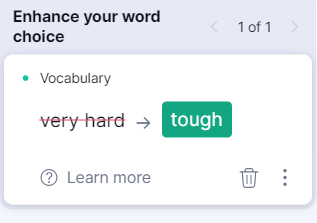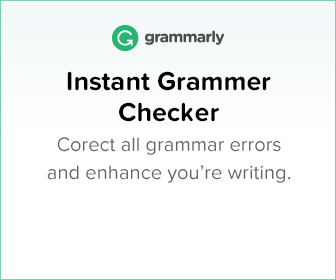In this article, we’ll talk about how to properly format your blog posts like a pro.
We will delve into various formatting techniques, tools, and best practices that will make your content stand out, engage your audience, and even potentially improve your search engine rankings.
Without further ado, let’s get started.
1. Match the reader’s intent early in the blog post
To capture and retain your readers’ attention, it is crucial to address their intent early in the blog post.
The introduction should clearly state what the article is about, what value it offers, and why readers should continue reading.
For question-based topics, you can start the body of the content by directly answering the question.
This way you quickly satisfy the search query while you break it down for further explanation across the body of the content.
By aligning with their intent, you establish relevance and increase the chances of them staying engaged throughout the post.
2. Use the Right Heading Markup Structure
- Title: Use the H1 heading tag for the title.
- Body: Use H2 headings for major sections and H3 headings for subsections to create a visual hierarchy.
- Conclusion: You can use H2 or H3 heading for the conclusion section.
3. Make Your Blog Post Skimmable and Scannable
Skimming is reading speedily to get a general overview of the material.
Scanning is reading rapidly to find specific facts.
While skimming tells you what general information is within a section, scanning helps you locate a particular fact.
In today’s fast-paced digital world, readers often skim through content to quickly find the information they need.
Making your blog post scannable allows readers to grasp the main points, scan for specific details, and decide whether to read the entire post.
Techniques for Enhancing Skimmability & Scannability
- Use subheadings: Break your content into sections and use descriptive subheadings. This helps readers navigate through the post and find relevant information easily.
- Utilize bullet points and numbered lists: Presenting information in a list format enhances readability and makes key points stand out.
- Highlight important keywords: Use bold, italics, or underlining to emphasize important words or phrases, making them more noticeable.
- Incorporate short paragraphs: Lengthy paragraphs can be overwhelming to readers. Keep paragraphs concise and focused to maintain reader engagement.
- Include visual elements: Images, charts, or infographics can break up the text, add visual appeal, and convey information more effectively.
4. Short, concise sentences and paragraphs are vital
Long, complex sentences and paragraphs can be challenging to read and understand.
Opt for shorter sentences and paragraphs to maintain reader engagement. Here’s how to go about it.
- Aim for an average sentence length of 15-20 words.
- Limit paragraphs to 3-4 sentences, focusing on a single idea or concept.
- Use transitional phrases to smoothly connect ideas and improve flow.
5. Incorporate Basic Content Formatting Options (Bold, italics)
Formatting options like bold, italics, and underlining can be used to emphasize important words, phrases, or quotes within the text.
- Use bold to highlight keywords or key takeaways.
- Italics can be used for emphasis or to introduce foreign words.
- Underlining is generally not recommended for online content, as it can be confused with hyperlinks. Use it only when necessary.
6. Quotes and block quotes
Quotes and block quotes are effective in providing evidence, supporting arguments, or featuring insights from experts.
- Use quotation marks for shorter quotes embedded within the text.
- For longer quotes or significant excerpts, consider using block quotes. Indent the quote, and use a different font style or highlight it to differentiate it from the main text.
7. Use a Table of Content
Including a table of contents at the beginning of your blog post provides several benefits.
It allows readers to quickly navigate to the sections that interest them, improves the overall user experience, and encourages readers to explore more of your content.
How to create a table of content
- Identify the main sections and subsections of your blog post.
- Assign corresponding headings and subheadings to each section.
- Create an ordered list of these headings and subheadings.
- Hyperlink each entry in the table of contents to its corresponding section within the blog post.
If you’re a WordPress user, then you can use a WordPress table of content plugin.
Placement of a table of content in a blog post
The table of contents is typically placed at the beginning of the blog post, after the introduction and before the main body content.
This ensures that readers have quick access to the navigation links, allowing them to jump directly to the sections they find most relevant.
8. Add Visual Elements in Blog Posts
– Use of images
Images are powerful visual elements that can enhance your blog post’s appeal, convey information, and evoke emotions. Choose relevant and high-quality images for your blog that align with your content.
- Optimize images for the web to ensure faster loading times.
- Add descriptive alt text to images for improved accessibility and SEO.
– Charts, graphs, and infographics
Visualizing data or complex information through charts, graphs, and infographics can make it easier for readers to understand and retain the information.
- Choose the appropriate type of visual representation for your data.
- Clearly label and provide explanations for the visuals to enhance comprehension.
– Videos and other multimedia
Videos are engaging and provide an immersive experience for readers.
Incorporating videos and other multimedia elements, such as audio clips or interactive elements, can further enhance the value of your blog post.
- Host videos on platforms like YouTube or Vimeo and embed them in your blog post.
- Ensure videos are relevant, high-quality, and add value to the content.
Proper formatting of visual elements
Ensure that visual elements are properly formatted and aligned within your blog post. Place images, charts, and videos in relevant sections and break up the text by inserting visual elements at appropriate intervals.
9. Optimize Content for SEO
Search Engine Optimization (SEO) plays a crucial role in improving the visibility of your blog post in search engine results.
Proper formatting techniques can contribute to better SEO rankings.
– Keyword placement
Strategically place relevant keywords throughout your blog post to signal search engines about the content’s topic and relevance.
Incorporate keywords in the title, headings, subheadings, and naturally within the body of the post.
– Image alt text
Optimize the alt text of your images by including relevant keywords. Alt text not only improves accessibility for visually impaired readers but also provides additional context for search engines.
– Meta descriptions and title tags
Craft compelling meta descriptions and title tags for your blog post. These snippets appear in search engine results and should entice users to click on your link.
– Linking strategies
Internal and external linking within your blog post can improve SEO and provide additional value to readers.
Use descriptive anchor text when linking to related content on your own blog or reputable external sources.
10. Incorporating a Call-to-Action (CTA)
A well-crafted call-to-action (CTA) encourages readers to take the desired action, such as subscribing to a newsletter, leaving a comment, or making a purchase. CTAs help in converting readers into engaged users and paying customers.
How to create an effective CTA
- Be clear and specific: Clearly state what action you want readers to take and provide a compelling reason to do so.
- Use action-oriented language: Use verbs that encourage action, such as “download,” “subscribe,” or “join.”
- Offer value: Highlight the benefits or value readers will receive by taking the desired action.
- Create a sense of urgency: Use words like “limited time offer” or “exclusive access” to create a sense of urgency and drive immediate action.
- Place the CTA strategically: Position the CTA where it is easily visible and consider repeating it at the end of the post.
11. Blog Post Aesthetics and Readability
Aesthetics and readability significantly impact the user experience and how readers perceive your blog post. Well-designed and visually appealing posts are more likely to attract and retain readers.
– Font selection
Choose a legible font for your blog post. Sans-serif fonts like Arial or Verdana are generally easier to read on screens.
Use font sizes that are comfortable to read, typically between 12 and 16 pixels.
– Color schemes
Select a color scheme that complements your brand and is visually pleasing. Use contrasting colors for text and background to ensure readability.
Avoid using too many colors, as it can be distracting.
– Use of whitespace
Whitespace, also known as negative space, refers to the empty space between elements in your blog post. It helps create visual breathing room, improves readability, and highlights important content.
Use ample whitespace to give your blog post a clean and uncluttered look.
– Mobile responsiveness
Optimize your blog post for mobile devices, as an increasing number of users access content on smartphones and tablets.
Ensure that your blog post is responsive and adjusts seamlessly to different screen sizes.
12. Proofreading and Editing
– Review for grammar, spelling, and punctuation errors
Ensure that your blog post is free from grammar, spelling, and punctuation mistakes.
Mistakes can undermine your credibility and distract readers from your message.
Use grammar and spell-check tools to identify errors, but also manually proofread for accuracy.
– Check for clarity and coherence of ideas
Read through your blog post to ensure that your ideas flow logically and are easy to understand.
Eliminate any confusing or ambiguous statements and make sure your message is clear and concise.
– Verify formatting consistency
Check for consistent formatting throughout your blog post.
Ensure that headings, subheadings, fonts, and spacing are uniform.
Consistent formatting improves readability and enhances the overall aesthetic of your blog post.
Best Blog Post Formatting Tool
There are various formatting tools available that can assist you in creating visually appealing and well-structured blog posts but the must-have for all bloggers is Grammarly.
Grammarly helps you identify grammar, spelling and punctuation errors with ease.
It has a downloadable free plan and a premium plan for in-depth grammar/editing features.
5 Common Blog Post Formatting Mistakes and How to Avoid Them
| No. | Common Blog Post Formatting Mistakes | Tips to Avoid Them |
|---|---|---|
| 1 | Large Walls of Texts | Break up your content into short paragraphs to enhance readability and scannability, utilize white spaces |
| 2 | Lack of headings | Use clear and descriptive headings and subheadings to guide readers through the content. |
| 3 | Poor Heading Markup Structure | Use the right heading markups. H1 for titles, H2 for sub headings and H3 for nested sub headings |
| 4 | Inconsistent formatting | Maintain consistent formatting throughout your blog post, including font styles, sizes, and spacing. |
| 5 | Ignoring mobile responsiveness | Ensure that your blog post is responsive and visually appealing on different screen sizes. |
I’ve created a complete guide on starting a blog, you can see it here:
How to Start a Profitable Blog: A Detailed Step-By-Step Guide
FREQUENTLY ASKED QUESTIONS
– How long should my blog post be?
The ideal length of a blog post depends on various factors, including the topic, audience, purpose and content depth.
Aim for a length that provides comprehensive information while maintaining reader engagement, typically between 1,000 and 2,000 words.
– Should I use images in every blog post?
While using images is not compulsory, they can enhance the visual appeal and engagement of your blog posts.
Images can break up the text, convey information more effectively, and create a more engaging reading experience.
– Is it compulsory to use writing tools for formatting blog posts?
Using writing tools for formatting blog posts is not compulsory, but it can greatly assist in creating well-structured blog posts and saves lots of manual editing time.
These tools often include grammar and spell-check functions, readability analysis, and suggestions for improving sentence structure and clarity.
They can also help ensure consistency in formatting, such as proper capitalization, punctuation, and paragraph spacing.
– How often should I update old blog posts?
At least once every 6 – 7 months. It’s recommended to review and update your old blog posts especially those that are outdated or underperforming.
Updating them with fresh content, formatting improvements, and better SEO optimization can breathe new life into them and improve their overall performance.
Final Thoughts on How to Properly Format Blog Posts
While content is king, formatting plays a crucial role in delivering that content effectively.
Remember, formatting your blog posts is not just about aesthetics; it’s about creating an engaging and user-friendly experience for your readers.
By following the guidelines in this complete guide, you’ll be able to captivate your audience, improve readability, and optimize your blog posts for success.
Till we meet again on another article,
Do have a nice day!








0 Comments